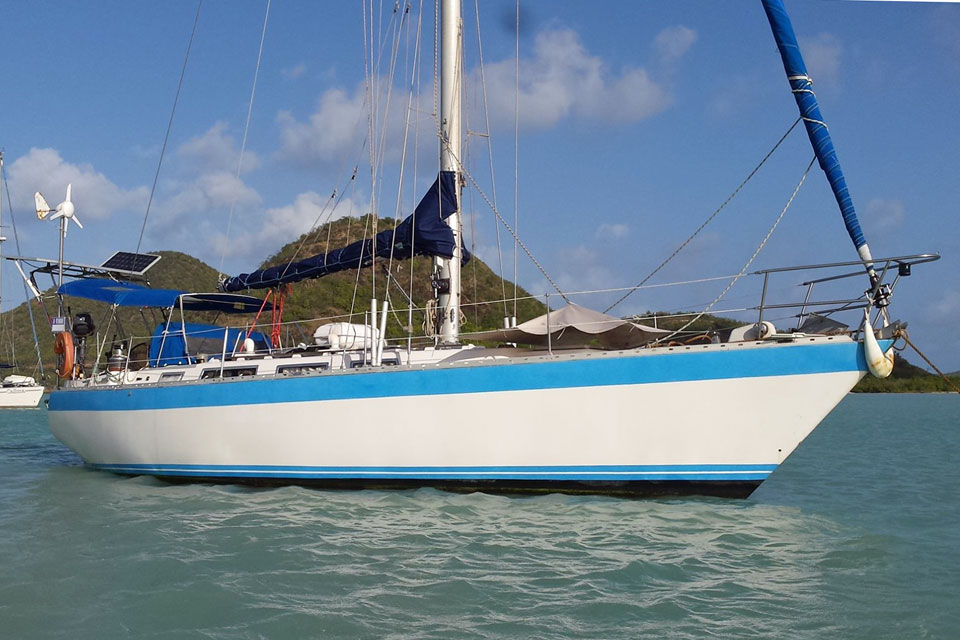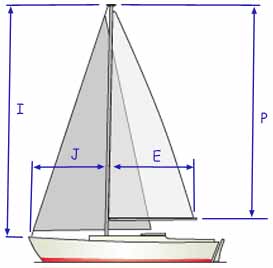- Home
- Cruising Yachts 35' to 40'
- Hood 38 Specs
The Hood 38
Specs & Key Performance Indicators
The Hood 38 sailboat, designed by American naval architect Ted Hood, was built by Wauquiez, a shipyard located in France. First constructed in 1978, the Hood 38 features a fiberglass hull, a stub keel with a centerboard, and a spade rudder.
 The Hood 38 Masthead Sloop
The Hood 38 Masthead SloopPublished Specification for the Hood 38
Keel & Rudder Configuration: Stub keel with centerboard and spade rudder
Hull Material: Fiberglass
Length Overall: 11.6m (38'0")
Waterline Length: 9.3m (30'5")
Beam: 3.6m (11'10")
Draft: Centreboard up - 1.4m (4'6"), Centreboard down - 3.3m (10'10")
Rig Type: Masthead Sloop
Displacement: 10,590 kilograms (23,348 pounds)
Ballast: 5,000 kilograms (11,023 pounds)
Hull Speed: 7.2 knots
Designer: Ted Hood
Builder: Wauquiez
Year First Built: 1978
Year Last Built: 1989
Number Built: 179
Options & Alternatives
- Mark I: This was the original version produced from 1978. It featured the standard layout and design elements initially conceived by Ted Hood.
- Mark II: Introduced around 1985, the Mark II version included several modifications. The most notable changes were direct access to the companionway steps from the cockpit and a slightly different interior layout.
Additionally, the same hull design was later offered in the US as the Little Harbor 38 and the Bristol 38.8.
Sail Areas & Rig Dimensions

I: 15.5 meters (51 feet)
J: 4.7 meters (15.5 feet)
P: 13.6 meters (44.5 feet)
E: 4.3 meters (14 feet)
Total Sail Area: 65.7m2 (707ft2)
Mainsail Area: 28.9m2 (311.5ft2)
Foresail Area: 36.7m2 (395.25ft2).
Published Design Ratios
The Key Performance Indicators (KPIs)
Sail Area/Displacement Ratio (SA/D): 17.4
Ballast/Displacement Ratio (B/D): 47.2%
Displacement/Length Ratio (D/L): 385.3
Comfort Ratio: 41.5
Capsize Screening Formula: 1.66
Based on the these ratios, the theoretical sailing characteristics of the Hood 38 sailboat are:
- Sail Area/Displacement Ratio (SA/D) 17.4: This ratio indicates that the Hood 38 has reasonably good performance potential. It is not underpowered (below 16) but also not in the high-performance range (above 20). This suggests that the sailboat will perform well under various sailing conditions, offering a good balance between speed and power.
- Ballast/Displacement Ratio (B/D) 47.2%: With a B/D ratio of 47.2%, the Hood 38 is considered a stiff boat. Such a high ballast percentage indicates that the sailboat is better able to stand up to the wind, providing stability and making it more capable of handling stronger winds without excessive heeling.
- Displacement/Length Ratio (D/L) 385.3: The D/L ratio places the Hood 38 in the "Ultraheavy Displacement" category. This means the boat is quite heavy relative to its length. Sailboats in this category require more sail area to reach their hull speed, meaning the Hood 38 will not accelerate as quickly and will have a slower response to wind changes but will provide a smoother ride in heavy seas.
- Comfort Ratio 41.5: The Comfort Ratio indicates very comfortable motion characteristics, aligning with what you'd expect from a heavy bluewater cruising boat. With a value of 41.5, the Hood 38 is designed to provide a stable and comfortable experience, especially suited for ocean passages where motion comfort is crucial for longer trips.
- Capsize Screening Formula 1.66: A Capsize Screening Formula value of 1.66 suggests that the Hood 38 is well-suited for ocean passages. Since the value is well below the threshold of 2.0, it indicates a lower susceptibility to capsizing in rough seas, making it a safer choice for bluewater sailing.
Summary:
The Hood 38 sailboat, with its reasonably good SA/D ratio, high B/D ratio, ultraheavy displacement, high comfort ratio, and low capsize screening value, is well-suited for bluewater cruising. Its design emphasizes stability, comfort in motion, and safety, making it a good choice for sailors planning extended offshore voyages or ocean passages. While it may not be the fastest boat in moderate winds compared to lighter designs, it offers excellent handling in heavy weather and a comfortable ride over long distances.
Here's how to calculate the KPIs yourself - without having to wrestle with the mathematics...
Design Ratios: Notes of Caution...
- The Sail Area/Displacement Ratio (SA/D): This ratio provides an estimate of the sail power relative to the boat's weight, which can indicate potential speed in various wind conditions. But it doesn't account for the efficiency of the sail plan, the rigging, or the skill of the crew. Real-world performance can vary significantly based on these factors.
- The Ballast/Displacement Ratio (B/D): This ratio gives an idea of the boat's stability and stiffness, which is crucial for handling and safety. But it doesn't consider the distribution of the ballast or the hull shape, both of which can greatly affect stability. A high B/D ratio alone doesn't guarantee a stable boat if the ballast is poorly distributed.
- The Displacement/Length Ratio (D/L): This ratio helps predict the boat's speed potential and its behaviour in different sea conditions. But it doesn't account for the hull design or the boat's overall weight distribution. Two boats with the same D/L ratio can perform very differently if their hull shapes are different.
- The Comfort Ratio (CR): This ratio estimates the boat's motion comfort in a seaway, which is important for long passages. But it doesn't consider the boat's interior layout, which can also affect comfort. Additionally, personal tolerance to motion varies, so a boat that is comfortable for one person might not be for another.
- The Capsize Screening Formula (CSF): This formula assesses the likelihood of a boat capsizing in heavy seas, which is critical for offshore safety. But it doesn't take into account the boat's handling characteristics or the skill of the crew. A boat with a low CSF can still capsize if poorly handled in severe conditions.
General Limitations
- Static Nature: These ratios are static measurements and don't account for dynamic factors like wave action, wind gusts, or crew actions.
- Simplification: They simplify complex interactions into single numbers, which can be misleading. Real-world performance is influenced by a multitude of factors that these ratios can't fully capture.
- Context: The context in which the boat is used (e.g., coastal cruising vs. offshore racing) can greatly affect how these ratios should be interpreted.
In summary, while these ratios provide valuable insights into the theoretical performance characteristics of a sailboat, they should be used as part of a broader assessment that includes practical experience, sea trials, and expert advice.
This article was written with the assistance of Gemini, a large language model developed by Google. Gemini was used to gather information, summarize research findings, and provide suggestions for the content and structure of the article.
Recent Articles
-
Hans Christian 43: Classic Bluewater Cruiser & Liveaboard Sailboat
Dec 10, 25 04:37 AM
Explore the Hans Christian 43: a legendary heavy-displacement, long-keel sailboat. Read our in-depth review of its specs, design ratios, and suitability for offshore cruising and living aboard. -
Planning Your Sailboat Liveaboard Lifestyle: An Ocean Sailor's Guide
Dec 06, 25 05:18 AM
Seasoned sailors share their methodical risk analysis for planning a secure Sailboat Liveaboard Lifestyle, covering financial, property, and relationship risks. -
Marine Cabin Heaters: The Expert’s Guide to Comfort & Safety at Sea
Dec 05, 25 06:52 AM
Choose the best Marine Cabin Heaters for your vessel. Expert advice on diesel, paraffin, and hot water systems for year-round cruising comfort.












